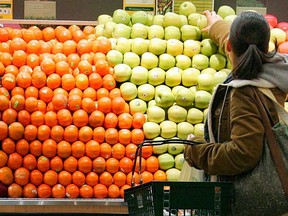A new survey showed that 37 per cent of Albertans are sharing household, grocery and childcare bills to sustain rising living costs in the province

The accounting firm’s latest Consumer Debt Index released Tuesday highlighted that 37 per cent of Alberta respondents have turned to cost-sharing measures like bill-splitting, carpooling, buying in bulk and sharing costs for childcare, subscriptions and rent with others to pay the bills.
Thirty-five per cent of Albertans have also said they are eating less to mitigate household costs, the report adds.
“Proportionally .. the gap between wages and the cost of living has rapidly closed and it’s just a big adjustment for people who have been here a long time,” Lindsay Burchill, a Calgary-based licensed insolvency trustee and vice-president of consumer insolvency for MNP Ltd., said.
Costs of housing, food, living have “really increased in the past three to four years,” she said. “Basic needs are where the biggest struggles are for Albertans right now.”
Ipsos, on behalf of MNP Ltd., interviewed 2,000 Canadians aged 18 years between September 6 and September 11 and weighted the results to ensure the sampled demographics reflects that of the general population for the survey.
Alberta no longer the affordable place it was
The rise in living costs presents a “learning curve” for those who have lived in Alberta for years and are now seeing their income levels drop relative to daily expenses.
“We don’t have as much of a culture of shared accommodations as a metro like Vancouver or Toronto,” Burchill said. “I would wonder if there’s a shift in capacity, (for example), if I have a three-bedroom house that I’m having difficulty making the mortgage payment on, maybe I can rent out a room .. whereas in Toronto or Vancouver there was already a lot of that happening.”
“We are learning,” Burchill said. “We are taking these measures and we’re using them, in a greater proportion than some other provinces to manage those expenses. We adapt quickly and that’s reflected in the overall results. But it does point to an underlying problem on affordability.”
Despite the gloomy outlook, the survey reports Albertans are hopeful for the future, with 27 per cent of respondents — eight points higher than last polled — expecting their debt situation to improve over the next year.
Fourteen per cent of respondents — 3 points lower than last polled — believe the situation might worsen while 19 per cent of those polled believe they are better placed to manage an interest rate increase of one percentage point.
“Some of these cost-cutting measures have created a little bit of cushion in their budget,” Burchill said.
The report listed bill splitting, avoiding impulse buys, scrimping on utilities and finding more affordable places to stay as some of the most preferred measures to cut costs.
Albertans also listed recording expenses, strategically grocery shopping, moving in with family or roommates and being stringent on miscellaneous costs like eating in restaurants or purchasing subscriptions as other ways of cutting down on monthly bills.
Albertans still struggling to save and meet living costs
According to the report, Alberta respondents said they were able to save up to $779 on average at the end of the month, $44 more than reported in the last quarter.
While the report presents a comparatively more positive outlook on Albertans’ personal finances for the next year, Burchill said that’s not necessarily the case for “many Albertans,” based on observations of those who visit her office for help.
“They have absolutely evaporated all their savings capacity, they’ve had to dip into their savings over the past few years just to stay afloat and they’ve potentially gotten into further debt,” Burchill said. “It’s still a really difficult situation for many.”
“People are still really on the edge”, Burchill said.
Since the pandemic, the proportion of Albertans struggling to meet costs for basic living needs has risen from approximately 15 per cent to nearly half, according to Meaghan Reid, executive director for Vibrant Communities Calgary, a local non-profit.
Compared to 20 years ago, it’s a lot harder to tell who’s struggling, Reid said. “Poverty can exist behind the doors of that nice neighbourhood and it’s existing in workplaces that seem to have very good salary rates. So it’s harder to understand the problem and the scope of it because it just looks so much different than it used to.”
“The numbers we used to rely on in terms of income support to tell us who’s struggling with affordability just don’t tell that story anymore,” she said.
Food insecurity on the rise
Food insecurity, Reid said, has especially been on the rise post-pandemic. For example, most emergency food agencies that opened during the pandemic to support communities have not yet wound down because they’re “still meeting a very high need of people who are food insecure,” she said.
“Food insecurity has been the canary in the coal mine of affordability over the past four or five years,” Reid said, explaining when people face financial pressures and have to sacrifice one expense for another, food is often one that is deprioritized.
Twenty-nine per cent of Calgarians worry about running out of food, the report reads.
The report also found while 74 per cent of people who earn anywhere between $30k to $90k can meet their basic financial needs, only 50 per cent of people rate their lives as good or excellent.
“If you’re not affording healthy food, that really affects people’s development and physical health,” Reid said, “and if we don’t have housing security, that affects people’s ability to concentrate on prosperity. There’s just so many knock-on effects that this current affordability crisis is having that I’m not sure we recognize entirely in terms of severity.”